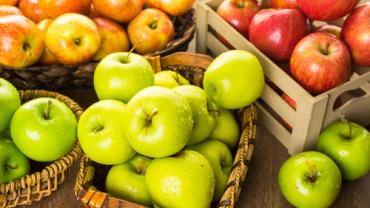
Visit a supermarket just about anywhere in North America any time of year, and you’ll find several different kinds of apples: Macintosh, Red and Golden Delicious, Granny Smith, Gala, and maybe, if the store is especially well-stocked, an occasional Fuji, Rome, or Honeycrisp. Visit a farmers’ market in certain areas, however, and you may come across cultivars you’ve never heard of: Smokehouse, Elstar, Stayman, Jonagold, Empire. Each cultivar has a unique flavor profile and texture, making some better suited for snacking, while others are better baked in pies or cooked in savory dishes.
If an apple a day ever kept the doctor away, though, it probably wasn’t because of apples’ nutrient content. The truth is, when it comes to vitamins and minerals, apples don’t have all that much going for them. But that doesn’t mean they don’t have a place at the table or in the lunch sack. Apples have a long and storied mythology and culinary history, and they wouldn’t have the staying power they’ve had through the millennia if there weren’t something good about them.
The nutrient content of individual apple cultivars varies slightly, but generally, raw apples consumed with the skin contain small amounts of vitamins C and K, potassium, and trace amounts of other vitamins and minerals. Apples are fairly high in natural sugars but also provide a good amount of dietary fiber. Beyond the basics, apples are rich in several beneficial phytochemicals. In the United States, apples are the largest dietary source of phenolics, accounting for 22% of the total phenolics consumed from fruit. Among thirteen different apple cultivars tested, all were high in phenolics, but Fuji, Red Delicious, Gala, and Liberty were the highest. Among commonly consumed fruit in the U.S., apples are second only to cranberries in total antioxidant activity, and are even ahead of red grapes and strawberries, which are both frequently cited for their antioxidant content.
One of the many antioxidants in apples is quercetin, which is also found in red onions, red wine, dark colored berries, parsley, and olive oil. A number of health-promoting properties have been ascribed to quercetin, such as being anti-inflammatory, and it may also be helpful for improving insulin sensitivity in people with insulin resistance. Quercetin may be an even more powerful compound than resveratrol, the antioxidant red wine and grapes are known for.
Another potent antioxidant apples are a rich source of is chlorogenic acid (CGA). CGA is also anti-inflammatory, may help improve blood glucose control and reduce insulin resistance, and may be beneficial for neurological and brain health. Additional sources of CGA are other fruits, coffee, tea, wine, and olive oil—foods that typically appear on lists of “healthful foods” and foods consumed by centenarians. Perhaps CGA is one of the many elements these foods have in common, and why epidemiological studies consistently cite fruits and vegetables as being major contributors to health and longevity. Most likely, however, it’s not the chlorogenic acid, itself, nor the quercetin, nor the resveratrol, but rather, synergies that happen among the myriad phytochemicals these foods and beverages contain—the compounds we know about, and the ones we have yet to identify.
As for ways to incorporate apples into the diet, nothing’s easier than grabbing one from the fridge or countertop fruit bowl and biting right in. But when times call for something a little more impressive, or just an interesting new dish to bring to the table, apples go way beyond pie or after-school snacks. Apples are a classic pairing with pork dishes in autumn (think bacon & apple smothered pork chops, apple-cinnamon pork loin, or honey-ginger-apple shredded pork), and they’re an excellent ingredient in stuffing/dressing or as a side dish at Thanksgiving.
Apples might not keep the doctor away, but they’ll keep boring meals at bay!
Sources: